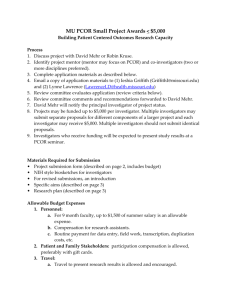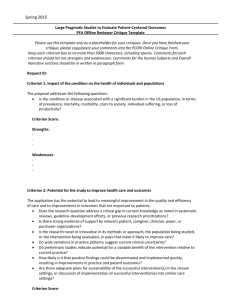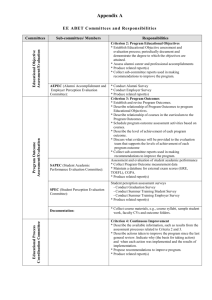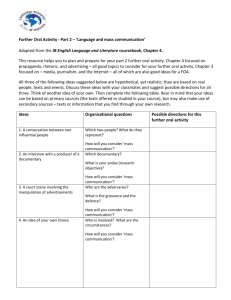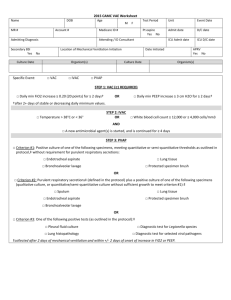View - Center for Patient-Centered Outcomes Research
advertisement
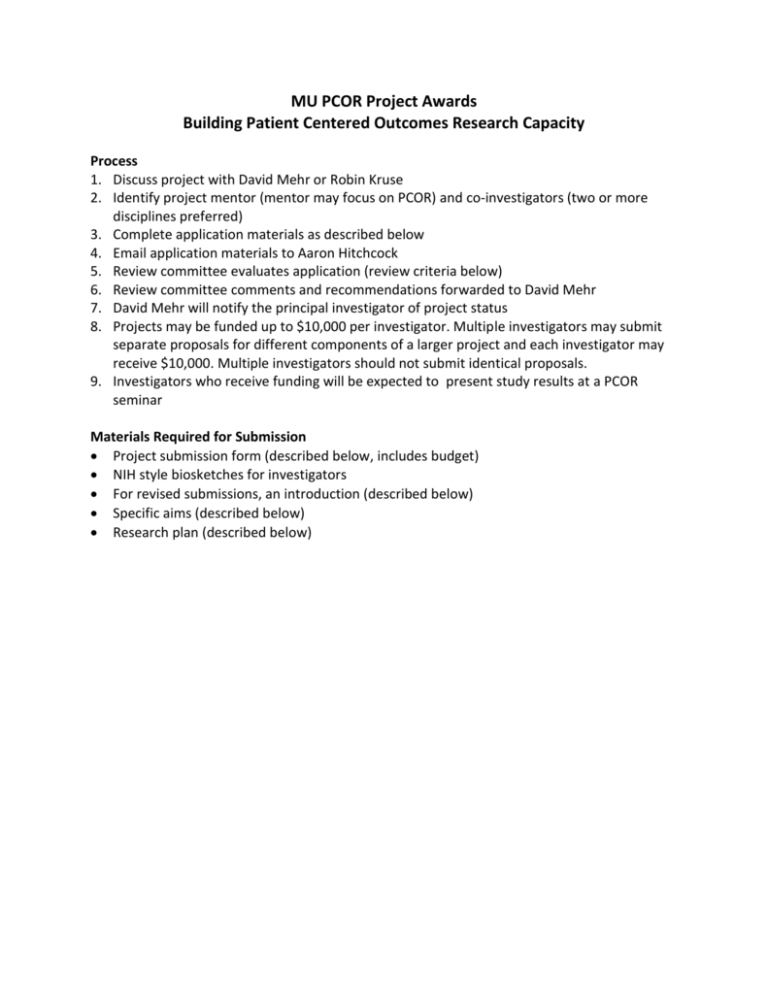
MU PCOR Project Awards Building Patient Centered Outcomes Research Capacity Process 1. Discuss project with David Mehr or Robin Kruse 2. Identify project mentor (mentor may focus on PCOR) and co-investigators (two or more disciplines preferred) 3. Complete application materials as described below 4. Email application materials to Aaron Hitchcock 5. Review committee evaluates application (review criteria below) 6. Review committee comments and recommendations forwarded to David Mehr 7. David Mehr will notify the principal investigator of project status 8. Projects may be funded up to $10,000 per investigator. Multiple investigators may submit separate proposals for different components of a larger project and each investigator may receive $10,000. Multiple investigators should not submit identical proposals. 9. Investigators who receive funding will be expected to present study results at a PCOR seminar Materials Required for Submission Project submission form (described below, includes budget) NIH style biosketches for investigators For revised submissions, an introduction (described below) Specific aims (described below) Research plan (described below) Pilot Project Submission Form 1. Project title: 2. Principal investigator: 3. Co-investigators: 4. Principal investigator department: 5. Project mentor (required): 6. Projected start and end dates: 7. Itemized budget: 8. Justification for funding request: INTRODUCTION (Allowed only on resubmissions, limit to 1 page) Summarize significant changes in application since previous submission. SPECIFIC AIMS (Limit to 1 page) In this section, concisely state the goals of the proposed research. Describe the study design, the research questions (hypotheses), the comparisons to be evaluated and the outcomes that will be studied, and describe the anticipated impact of study results on clinical or patient decision making and on patient outcomes. RESEARCH STRATEGY (Limit 6 pages single spaced content for sections A through G below) A. Background Describe the degree to which the condition imposes a significant burden on the health of individuals and/or populations. (Criterion 1, review criteria information follows the research strategy outline) B. Significance Describe how the specific aims relate to the significance of the proposed research study. Describe how the results of the study would likely improve health care and outcomes. (Criterion 2) Describe the study’s level of patient-centeredness. (Criterion 4) C. Study Design or Approach Describe the research strategy or methodological approach. Demonstrate the study's technical merit. (Criterion 3) D. Project Milestones Describe the projected outcomes and clearly articulate the proposed goals to be accomplished during the course of the research study. E. Patient Population Describe the study population with respect to age, gender, race, ethnicity, and clinical status as appropriate for the study. F. Research Team and Environment Describe the capabilities of the research team to accomplish the goals of the proposed research project, and the appropriateness of the research environment to conduct the study. G. Research Engagement Plan Describe the plan to engage patients and stakeholders meaningfully in all phases of the proposed research or how the proposed project will develop this level of engagement if the proposed project is pilot work for the development of a larger project. (Criterion 5) H. References cited in the application should be no longer than one page. Review Criteria: Criterion 1. Impact of the condition on the health of individuals and populations The proposal addresses the following questions: Is the condition or disease associated with a significant burden in the US population, in terms of prevalence, mortality, morbidity, individual suffering, or loss of productivity? Alternatively, does the condition or disease impose a significant burden on a smaller number of people who have a rare disease? Does the proposal include a particular emphasis on patients with one or more chronic condition? Criterion 2. Potential for the study to improve health care and outcomes The proposal has the potential to lead to meaningful improvement in the quality and efficiency of care and to improvements in outcomes that are important to patients. It addresses the following questions: Does the research question address a critical gap in current knowledge as noted in systematic reviews, guideline development efforts, or previous research prioritizations? Has it been identified as important by patient, caregiver, or clinician groups? Do wide variations in practice patterns suggest current clinical uncertainty? Is the research novel or innovative in its methods or approach, in the population being studied, or in the intervention being evaluated, in ways that make it likely to improve care? Do preliminary studies indicate potential for a sizeable benefit of the intervention relative to current practice? How likely is it that positive findings could be disseminated quickly and affect changes in current practice? Criterion 3. Technical merit The proposal has the technical merit to ensure that the study goals are met. It includes: A clear research plan with rigorous methods and key milestones clearly articulated A research team with necessary expertise, and an appropriate project organizational structure A research environment sufficient to support the conduct of the work with appropriate resources A diverse study population with respect to age, gender, race, ethnicity, and clinical status as appropriate for research A focus on a defined population for whom effectiveness information is particularly needed Criterion 4. Patient-centeredness The proposal demonstrates patient-centeredness at every stage of the research. It addresses the following questions: Is the research focused on questions that affect outcomes of specific interest to patients and their caregivers? Does the research address one or more of the key questions mentioned in PCORI’s definition of patient-centered outcomes research? How credible are claims that engaged patients and stakeholders will exert meaningful influence on the design and conduct of the research, to ensure patient-centeredness of the questions and outcomes addressed? Criterion 5. Patient and stakeholder engagement The proposal integrates patients and stakeholders in the development of the research plan and in key elements of conducting the research. It addresses the following questions: Does the proposal describe how patients and stakeholders were or will be identified and engaged in the research? Are the roles of patients and key stakeholders significant in formulating the study’s research questions, hypotheses and design and in the study’s conduct and dissemination of results? Are the roles proposed for patients and stakeholders in any planned dissemination or implementation plans meaningful and likely to be effective? If engagement is not applicable to the proposed research, does the application justify why it is not?
